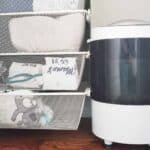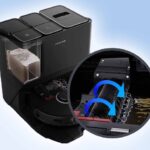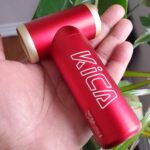There’s nothing better than a nice smoothie in the morning. All of those helpful nutrients, minerals, and vitamins are a great way to give your body a little jump-start in the morning.
However, there always is the risk of a little splashback Making your kitchen an absolute mess, especially if you’re in a rush to leave your home.
Immersion blenders are one of the best ways to get your smoothie fix in the morning, with a wide range of cheap and effective models out there right now.
It doesn’t even have to be limited to smoothies; an immersion blender can blend… well, anything!
You can keep your kitchen clean and still enjoy your immersion blender.
After many attempts, I found the best way to operate an immersion blender and avoid splashing is by using a steep-walled container, turning it on only after fully submerged, and making small verticle movements with the device until food reaches desired consistency.
It might take a bit of practice to get the hang of it, but once you get it, you’ll be living that splash-free life. 🙂
I’ve been doing some research into the best ways to keep your immersion blender from making a mess in your kitchen. All of which can be applied with minimal effort.
Let’s take a closer look at how to keep your immersion blender from splashing!
How to Use an Immersion Blender Without Splashing
Immersion blenders have taken over the kitchen blending world, and there is a good reason for that.
They are highly effective, quick, and effortless. Not to mention cheap. Yet, there is one key drawback of an immersion blender.
Due to the open design of an immersion blender, they have a tendency to splash. Since we’re often blending thick smoothies or a delicious purée, this can add a significant amount of cleaning time.
Let’s explore some of the easiest methods of keeping your immersion blender from splashing.
Use a Larger Container
When you’ve decided to blend, it’s important to pick the right container for the job. The depth and diameter of the container you blend in are everything.
The deeper the bowl is, the more room you have to block those nasty splashes from making a mess.
This may seem obvious, but you’re likely using a bowl far too shallow for blending. Try picking out a deeper bowl, and see the results for yourself.
A container with a wider diameter is also helpful, especially if it comes with side covers.
This will provide more room for the vortex you’re creating, preventing purée or smoothie juice from splashing out of the vortex in the process.
Employ Better Hand Movements
When working with an immersion blender, an essential rule to follow is the hand rule.
A single wrong motion with your hand, and you can create a splatter that quickly gets out of control. So, you’re probably wondering, what is the hand rule?
When blending, never move your hand in a horizontal and round motion.
Instead, grip your immersion blender tight and move in a vertical fashion. This will break up the central vortex that forms, preventing splashback in the process!
Stick Holding Angle is Everything
When it comes to stopping splashing with your immersion blender, nothing is more important than keeping the correct angle. We often forget that the immersion blender only has small holes on either side. So, if you press the blender into a space where the liquid can’t escape, it’ll splatter.
Furthermore, holding the blender too high in the bowl can create the same effect. Providing too much room for the vortex to quickly grow out of control.
So, what is the correct angle for immersion blending?
You should aim to hold your immersion blender near the bottom without touching it.
If you touch the bottom, it’ll splatter. Instead, try to find that sweet spot just above the bottom. This will keep the vortex submerged and avoid any annoying clean-up after you’re done.
Using Container Attachment – Pro Tip
If you’re in the market for a new immersion blender.
This method, by far, is one of the best ways to nip splashing right in the bud.
There are several models that come with an attachment that turns and lock into your immersion blender. This is an excellent way to chop food too!
Your food is completely sealed, so you never have to worry about any splish splash.
Check out a few models on Amazon here.
Watch Your Blending Speed
A common mistake we all make with our immersion blenders is how we control the blending speed. There are some important rules you should follow that will drastically cut down the most common instances of splatter.
Firstly, never turn on the blender before it is submerged. Always submerge the blender, and then turn it on. This will stop the blender from suddenly splattering as it’s entering your bowl.
Secondly, make sure to watch the speed you blend at. You don’t have to set it to the highest setting straight away. Instead, start with a lower speed, and as you blend more, you can work up to a faster speed.
Avoid the Vortex Motion
When we blend something with an immersion blender, we create a vortex. This is unavoidable, as that’s how blenders work. However, it’s common for us to ignore one key rule when blending that causes a lot of splatters.
Creating another vortex with our hand movements.
Always avoid moving your hand in a circular motion, as this will feed the vortex that is already forming in the bowl—causing the vortex to grow in intensity and begin to splatter.
A good rule of thumb to remember is: As you see the vortex forming in the bowl, always try to cut it in half with your blender.
An up-and-down motion is best.
Not only will this cut down on the intensity of your blender’s vortex, but it will avoid any splatter that might occur because you’ve created another vortex sending everything out of control.
Create an Accessory
If you followed all of these tips, and still can’t get control of your splatter? Don’t worry! There is a last resort method that will make sure to stop that splatter in its tracks, by using an accessory to stop the splatter.
You can create a make-shift bowl lid from a paper plate in your home. Simply grab a paper plate and cut a hole in the top, just enough room to fit your blender. Then place the paper plate over the bowl, and then place the blender in.
This will catch 99% of the splatter that occurs, and all it costs you is a paper plate. What’s not to love about that?
You can achieve the same results by using a food plastic wrap(saran wrap). Place the saran wrap over the bowl or cup, then make a small slit just large enough for the head of your immersion blender to pass through.








